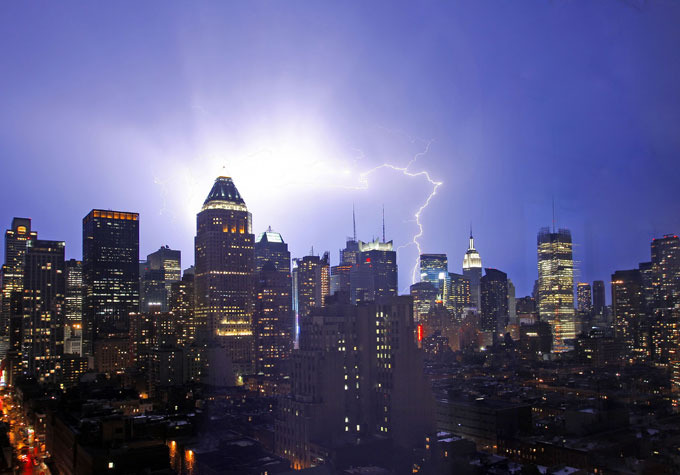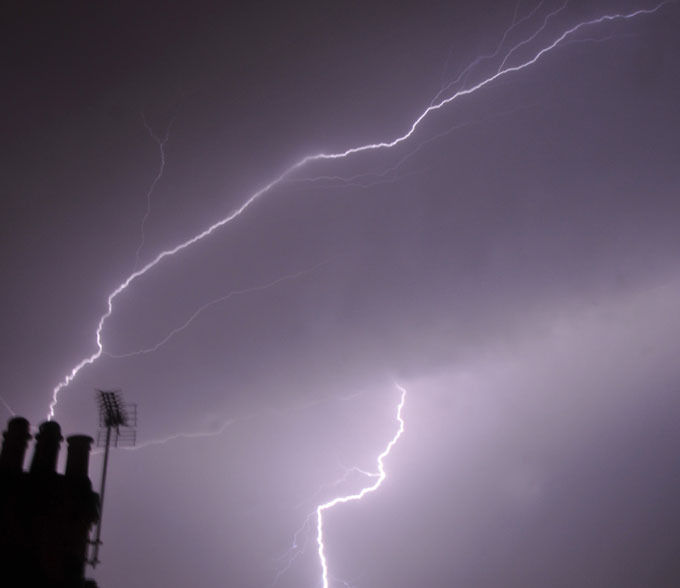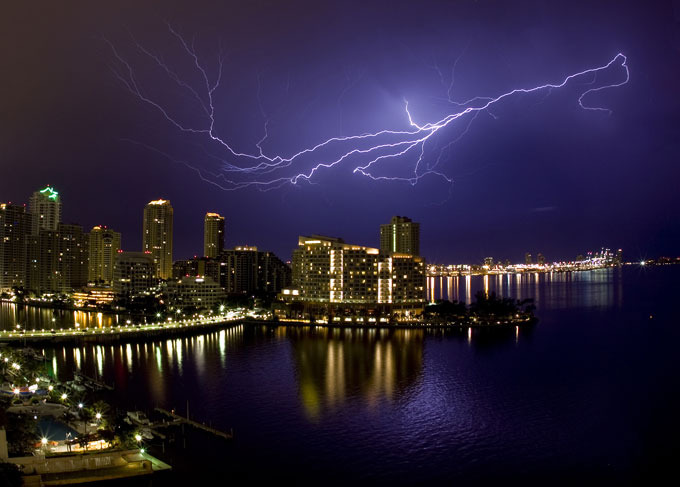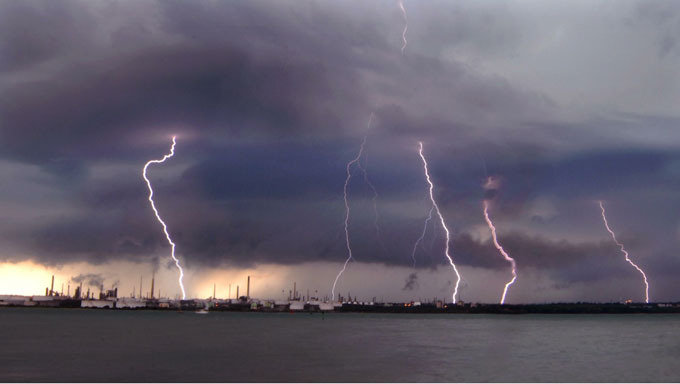Spectacular photos of lightnings

Lightning is an atmospheric electrostatic discharge (spark) accompanied by thunder, which typically occurs during thunderstorms, and sometimes during volcanic eruptions or dust storms
All photos: Splash/All Over Press
Lightning is an atmospheric electrostatic discharge (spark) accompanied by thunder, which typically occurs during thunderstorms, and sometimes during volcanic eruptions or dust storms
All photos: Splash/All Over Press

From this discharge of atmospheric electricity, a leader of a bolt of lightning can travel at speeds of 220,000 km/h (140,000 mph), and can reach temperatures approaching 30,000 °C (54,000 °F), hot enough to fuse silica sand into glass channels known as fulgurites which are normally hollow and can extend some distance into the ground
All photos: Splash/All Over Press
From this discharge of atmospheric electricity, a leader of a bolt of lightning can travel at speeds of 220,000 km/h (140,000 mph), and can reach temperatures approaching 30,000 °C (54,000 °F), hot enough to fuse silica sand into glass channels known as fulgurites which are normally hollow and can extend some distance into the ground
All photos: Splash/All Over Press

There are some 16 million lightning storms in the world every year. Lightning causes ionisation in the air through which it travels, leading to the formation of nitric oxide and ultimately, nitric acid, of benefit to plant life below.
All photos: Splash/All Over Press
There are some 16 million lightning storms in the world every year. Lightning causes ionisation in the air through which it travels, leading to the formation of nitric oxide and ultimately, nitric acid, of benefit to plant life below.
All photos: Splash/All Over Press

Lightning can also occur within the ash clouds from volcanic eruptions, or can be caused by violent forest fires which generate sufficient dust to create a static charge
All photos: Splash/All Over Press
Lightning can also occur within the ash clouds from volcanic eruptions, or can be caused by violent forest fires which generate sufficient dust to create a static charge
All photos: Splash/All Over Press

How lightning initially forms is still a matter of debate. Scientists have studied root causes ranging from atmospheric perturbations (wind, humidity, friction, and atmospheric pressure) to the impact of solar wind and accumulation of charged solar particles
All photos: Splash/All Over Press
How lightning initially forms is still a matter of debate. Scientists have studied root causes ranging from atmospheric perturbations (wind, humidity, friction, and atmospheric pressure) to the impact of solar wind and accumulation of charged solar particles
All photos: Splash/All Over Press

Ice inside a cloud is thought to be a key element in lightning development, and may cause a forcible separation of positive and negative charges within the cloud, thus assisting in the formation of lightning
All photos: Splash/All Over Press
Ice inside a cloud is thought to be a key element in lightning development, and may cause a forcible separation of positive and negative charges within the cloud, thus assisting in the formation of lightning
All photos: Splash/All Over Press

The irrational fear of lightning (and thunder) is astraphobia. The study or science of lightning is called fulminology, and someone who studies lightning is referred to as a fulminologist
All photos: Splash/All Over Press
The irrational fear of lightning (and thunder) is astraphobia. The study or science of lightning is called fulminology, and someone who studies lightning is referred to as a fulminologist
All photos: Splash/All Over Press

When the electric field becomes strong enough, an electrical discharge (the bolt of lightning) occurs within clouds or between clouds and the ground. During the strike, successive portions of air become a conductive discharge channel as the electrons and positive ions of air molecules are pulled away from each other and forced to flow in opposite directions.
All photos: Splash/All Over Press
When the electric field becomes strong enough, an electrical discharge (the bolt of lightning) occurs within clouds or between clouds and the ground. During the strike, successive portions of air become a conductive discharge channel as the electrons and positive ions of air molecules are pulled away from each other and forced to flow in opposite directions.
All photos: Splash/All Over Press

Dry lightning is a term in Canada and the United States for lightning that occurs with no precipitation at the surface. This type of lightning is the most common natural cause of wildfires. Pyrocumulus clouds produce lightning for the same reason that it is produced by cumulonimbus clouds
All photos: Splash/All Over Press
Dry lightning is a term in Canada and the United States for lightning that occurs with no precipitation at the surface. This type of lightning is the most common natural cause of wildfires. Pyrocumulus clouds produce lightning for the same reason that it is produced by cumulonimbus clouds
All photos: Splash/All Over Press

Reports by scientists of strange lightning phenomena about storms date back to at least 1886. However, it is only in recent years that fuller investigations have been made. This has sometimes been called megalightning
All photos: Splash/All Over Press
Reports by scientists of strange lightning phenomena about storms date back to at least 1886. However, it is only in recent years that fuller investigations have been made. This has sometimes been called megalightning
All photos: Splash/All Over Press



